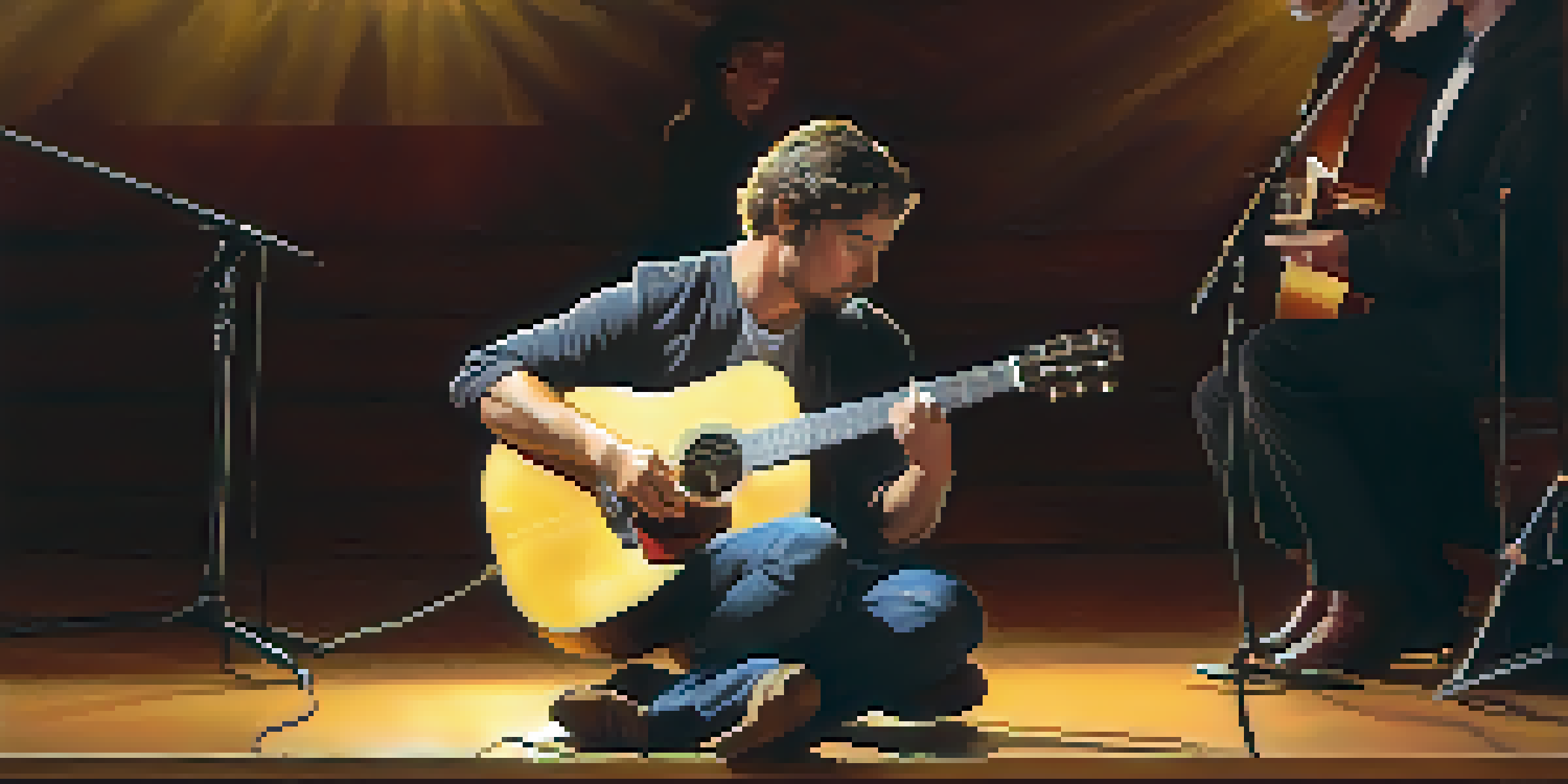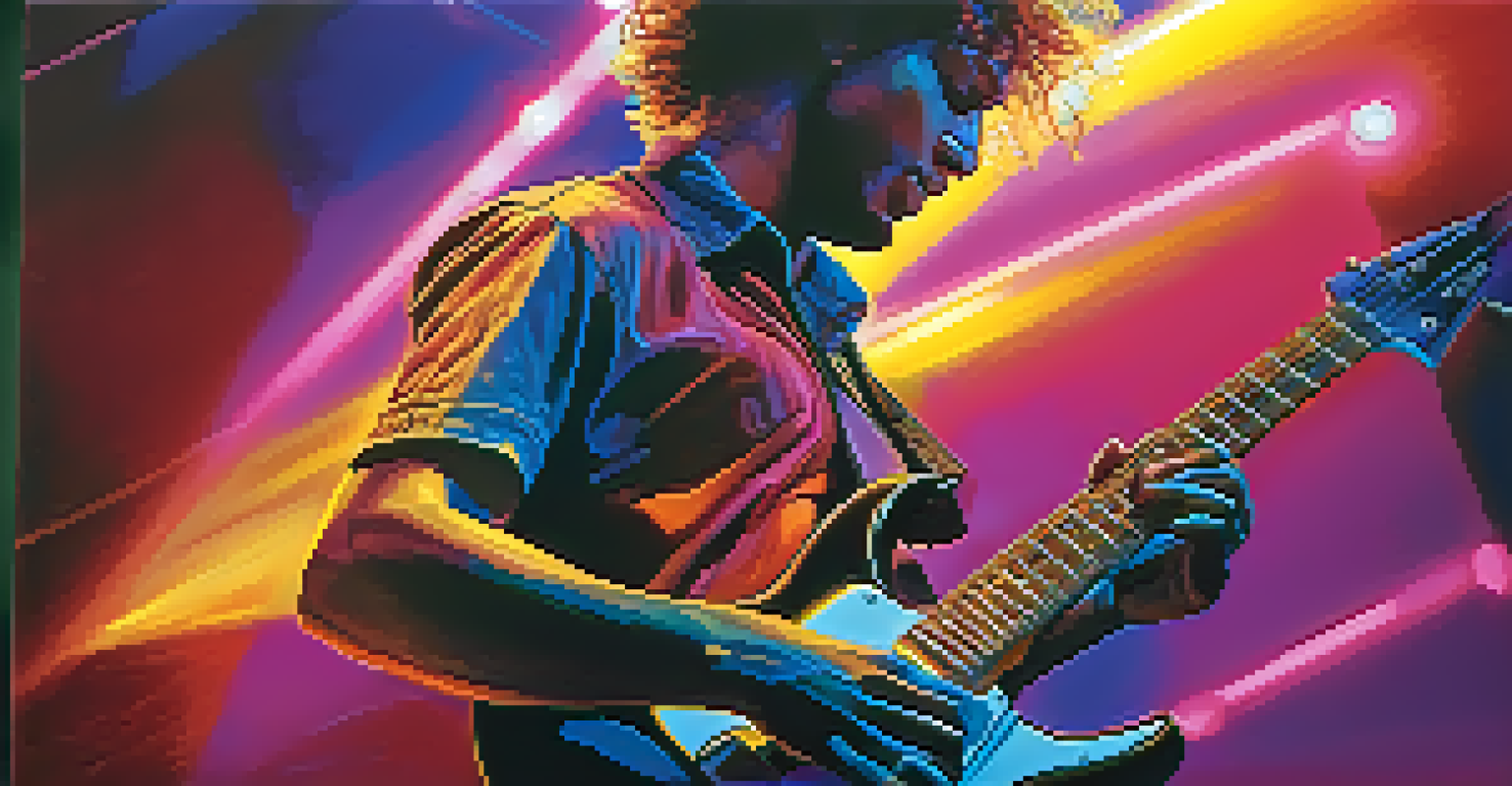Guitar as a Storytelling Tool in Film and Theatre

The Emotional Resonance of Guitar Music in Storytelling
The guitar has a unique ability to evoke emotions, making it a powerful storytelling tool in film and theatre. Its versatile range, from soft, delicate melodies to bold, powerful riffs, can mirror the emotional journey of characters. This instrument can convey a sense of longing, joy, or tension, often without the need for words. For instance, a gentle acoustic strum can set a reflective mood, while an electric guitar's screech can heighten a scene's intensity.
Music can change the world because it can change people.
Consider the emotional weight of a guitar solo in a pivotal film moment. Think about how a character's internal struggle can be amplified through a haunting guitar riff, drawing the audience deeper into their experience. This connection is often so profound that it can leave viewers with a lasting impression, long after the credits roll. The guitar thus becomes more than just an instrument; it transforms into a language of its own.
Moreover, the presence of a guitar can create a sense of familiarity and nostalgia, making it an ideal choice for storytelling. Many audiences have personal associations with guitar music, which can enhance their engagement with the narrative. By tapping into these emotions, filmmakers and theatre producers can craft a richer, more immersive experience for their audience.
Iconic Films That Showcase Guitar as a Storytelling Device
Several films have masterfully used the guitar to enhance their storytelling. Take 'Once,' for example, where the guitar serves as the voice of the protagonists' dreams and struggles. Each song they play narrates their journey, allowing the audience to connect with their hopes and heartbreaks. This seamless integration of music and narrative exemplifies how the guitar can be a character in its own right.

Another prime example is 'The Motorcycle Diaries,' where the guitar underscores the protagonist's adventures and self-discovery. The music interspersed throughout the film not only adds depth but also helps to portray the cultural context and emotional landscape of the scenes. The guitar becomes a bridge, connecting the audience to the character's experiences and the vibrant world around them.
Guitar Evokes Deep Emotions
The guitar's unique sound can convey a wide range of emotions, enhancing storytelling in both film and theatre.
These films illustrate that the guitar can articulate emotions and themes in ways dialogue sometimes cannot. By using the instrument to tell stories, filmmakers elevate the narrative, creating a richer emotional tapestry. The ability of the guitar to resonate with audiences enhances the storytelling experience, making it unforgettable.
The Role of the Guitar in Live Theatre Performances
In live theatre, the guitar plays a crucial role, often acting as a companion to the actors on stage. Its presence can enhance the mood of a scene and provide a sonic backdrop that complements the dialogue. For instance, musicals often utilize the guitar to create a sense of intimacy between characters during pivotal moments, allowing audiences to feel the tension or romance more deeply.
The guitar is a miniature orchestra in itself.
Moreover, the guitar can help set the pace and rhythm of a performance. In many productions, the strumming of a guitar can signal scene changes or transitions, guiding the audience through the narrative flow. This musical cue creates a seamless experience, ensuring that the storytelling remains engaging and dynamic.
The versatility of the guitar also means it can adapt to various genres of theatre, from contemporary plays to traditional musicals. Its ability to blend with different styles makes it a valuable asset for playwrights and directors. Ultimately, the guitar's contribution to live theatre enhances the storytelling, making it a vibrant part of the entire performance.
Guitar Techniques That Enhance Storytelling
Different guitar techniques can evoke specific feelings and atmospheres, further enriching storytelling in film and theatre. For instance, fingerpicking can produce a soft, intimate sound, perfect for reflective moments. In contrast, strumming can create a sense of urgency or excitement, energizing a scene and pulling the audience in.
Additionally, the use of effects like reverb or distortion can add layers to the music, enhancing the emotional depth. A dreamy, echoing sound can transport the audience to a different time or place, while sharp, distorted riffs can signify conflict or chaos. These techniques not only serve to support the narrative but also invite the audience to experience the story on a deeper level.
Cultural Significance of Guitar Music
Different styles of guitar music enrich narratives by providing cultural context, making stories more relatable and authentic.
By thoughtfully incorporating these techniques, composers and musicians can create a soundtrack that resonates with the audience's emotions. This thoughtful approach helps to weave music and storytelling together, resulting in a cohesive and powerful narrative experience. The guitar thus becomes an essential tool for crafting memorable moments in both film and theatre.
The Cultural Significance of Guitar Music in Storytelling
The guitar is not just a musical instrument; it carries various cultural significances that enrich storytelling. Different styles of guitar music, such as flamenco or blues, can evoke specific cultural contexts, enhancing the narrative's authenticity. By incorporating these styles into films and theatre, creators can provide audiences with a sense of place and time that deepens their understanding of the story.
For example, a flamenco guitar can transport viewers to the heart of Spain, while a blues riff may evoke the spirit of the American South. These cultural nuances allow filmmakers and playwrights to tell stories that resonate on multiple levels, bridging gaps between different backgrounds and experiences. The guitar, therefore, serves as a conduit for cultural expression.
This cultural richness can also foster a deeper connection between the audience and the characters. When viewers hear a guitar style that resonates with their own experiences or heritage, they may feel a stronger bond with the narrative. The guitar thus becomes a universal language, transcending barriers and inviting audiences into the heart of the story.
Innovative Uses of Guitar in Modern Storytelling
As storytelling evolves, so does the use of the guitar in film and theatre. Contemporary creators are experimenting with the guitar in innovative ways, blending genres and styles to create unique auditory experiences. For instance, combining traditional acoustic guitar with electronic elements can result in a fresh sound that enhances modern narratives.
These innovative approaches can also include unconventional guitar techniques, such as using unconventional tunings or incorporating percussive elements. This experimentation can add layers of complexity to the music, making it a dynamic part of the storytelling process. By pushing boundaries, creators can capture the audience's attention and keep them engaged.
Innovative Uses in Modern Storytelling
Contemporary creators are experimenting with guitar techniques, blending genres and multimedia to create dynamic storytelling experiences.
Furthermore, the rise of multimedia storytelling has allowed for even more creative uses of the guitar. With the integration of visual elements and technology, guitar music can be synchronized with visuals to create immersive experiences. This fusion of sound and sight deepens the connection between the audience and the story, making the guitar an indispensable tool in modern storytelling.
Conclusion: The Enduring Power of Guitar in Storytelling
In conclusion, the guitar remains a timeless storytelling tool in film and theatre, capable of evoking profound emotions and enhancing narratives. Its versatility allows it to adapt to various genres and styles, making it a valuable asset for creators. Whether through iconic solos or gentle strumming, the guitar can resonate deeply with audiences, leaving a lasting impression.
As storytelling continues to evolve, the potential for the guitar to innovate and inspire remains vast. With contemporary creators experimenting with new techniques and sounds, the future of guitar in storytelling looks bright. This instrument will undoubtedly continue to play a pivotal role in shaping narratives for generations to come.

Ultimately, the guitar is more than just an instrument; it is a powerful medium for connection and expression. Through its music, stories come alive, inviting audiences to feel, reflect, and engage in a shared emotional journey. As long as there are stories to tell, the guitar will remain a cherished tool in the world of film and theatre.